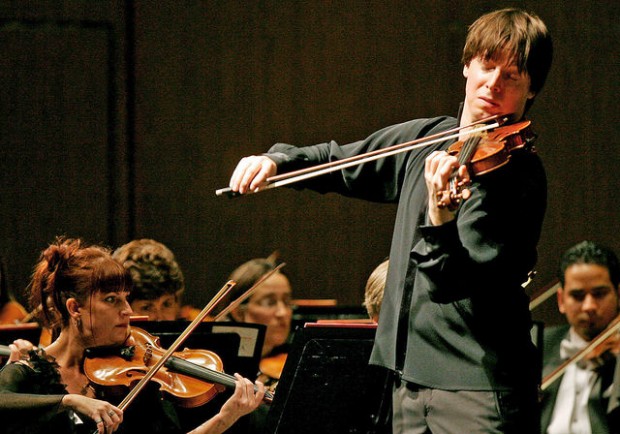The hall was dark except for a spotlight at center stage casting a warm glow on violinist Joshua Bell.
He arched his neck and drew the bow over his violin with the grace of a ballet dancer.
The room fell silent except for an errant cough.
For two minutes — alternately an eternity and a whisper in time — Bell took us to a place far removed from the Tucson Music Hall.
Less than 24 hours later, a few miles away at Centennial Hall, Itzhak Perlman plucked a single string to create a dissonant twang, then drew the bow across his violin.
He made it look easy as he danced through Poulenc’s virtuosic Sonata for violin and piano, with longtime accompanist Rohan De Silva.
We crossed over to nirvana.
You might expect to find Bell and Perlman playing back-to-back nights in New York City. Not in Tucson. But on Tuesday and Wednesday, the world’s two greatest living violinists performed sold-out concerts here.
First up: Bell
In the past few years, we have seen Joshua Bell perform with the Tucson Symphony Orchestra (2005) and with England’s Academy of St. Martin in the Fields (last spring).
We thought we had seen him at his best. We were wrong.
His sold-out TSO encore Tuesday was inspired.
Bell, 40, was poetry in motion, shifting his weight from his left foot to his right, leaning into his 1713 Gibson ex Huberman Strad. He seemed to disappear in the melodies of Bruch’s Violin Concerto No. 1 in G minor. We disappeared in him.
He is charismatic without being flashy or coy; his play is genuine, precise, warm and expert. His phrases employ modest vibrato and a sweet, pure tone that wraps itself around a room.
Bell has a commanding, expressive stage presence that quickly gives way to modesty when he is not playing. He acts as one with the orchestra, and on Tuesday he eagerly cast the attention on the TSO musicians, with whom he has formed a close bond.
“It’s a pleasure to be back here with this fabulous orchestra,” he said from the stage, a sentiment he echoed later while signing autographs for hundreds of fans.
We could not take our eyes off Bell. We were fixated throughout the Bruch and the sometimes dreamy swoon of Chausson’s “Poème.” We wanted him to stretch Corigliano’s “Pope’s Concert” from “The Red Violin” beyond its two minutes so that we could savor the moment and keep him to ourselves.
We were swept away.
Can music-making get any better than this?
And then there was Perlman.
Itzhak Perlman is called the greatest living violinist for good reason, as he proved once again Wednesday night. It was Perlman’s first Tucson concert since he performed on the same stage in 1999. Judging from the enthusiastic applause from the 2,526 people packed into the sold-out hall when he walked on stage, it had been too long.
Perlman’s program — Bach’s Sonata No. 3 in E major; Strauss’ Sonata for violin and piano in E-flat major; and Poulenc’s Sonata — sometimes put the piano on too equal a plane with the violin. But Perlman captured the spotlight with his rich, distinctive phrasing and expressive play.
He performs seated, his violin cocked under his chin, resting on a kerchief — the same kerchief he used several times to wipe sweat from his forehead. Throughout the concert, he proved he is the embodiment of technical perfection, drawing the purest tones from Bach’s Sonata. On the Poulenc Sonata, he alternated with equal ease between pizzicato and bow play — one instant he was plucking the strings, one, two, three at a time; in the next breath, he was bowing.
For his encore, Perlman and his longtime and engaging accompanist returned to the stage with a stack of scores. He thumbed through a computer printout listing all the works he has performed over the past 40 years. He wanted to ensure — perish the thought! — that he didn’t play something we’d heard in past concerts.
After sailing playfully through a couple short, unfamiliar pieces, he examined a sheet of paper that listed the titles of other works by lesser-known composers. Next to each was a description of the music that included the difficulty level involved.
“This says ‘very difficult,’ ” Perlman quipped, reading off the list. Then he retorted almost as an aside, “We’ll never play that one,” and the audience burst into giggles.
Finally he settled on Nicolo Paganini’s aptly named “Perpetual Motion” as arranged by famed violinist Fritz Kreisler. It’s an extremely virtuosic and demanding piece. The player alternates bowing and finger play at lightening speed.
Perlman plucked at the strings so fast and so precisely that each created a distinct note separate from the next. It was genius.
Perlman vs. Bell
For those who witnessed both concerts, it would be tempting to compare Bell and Perlman side by side. That would be a shame.
Instead, appreciate that you witnessed two of the greats — one who owns the title of the greatest, the other who is in line to assume that distinction.





